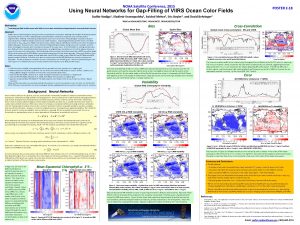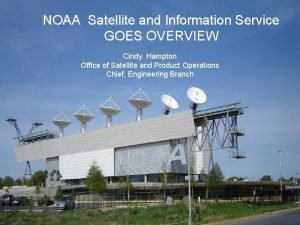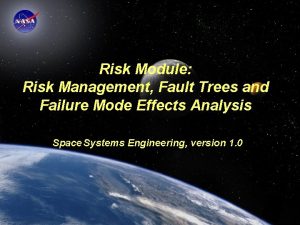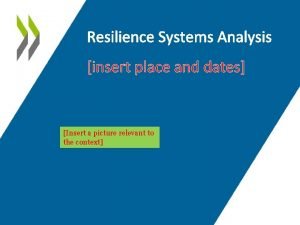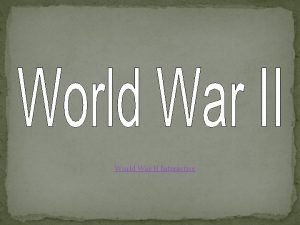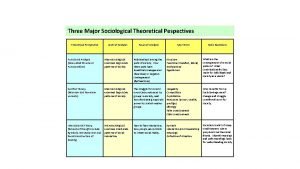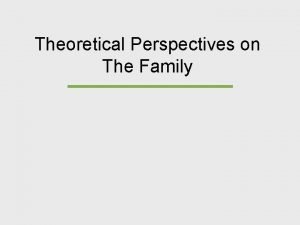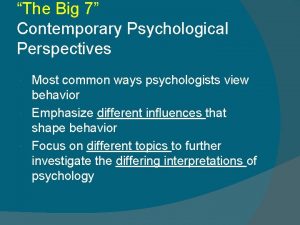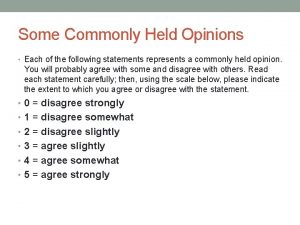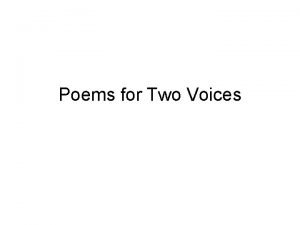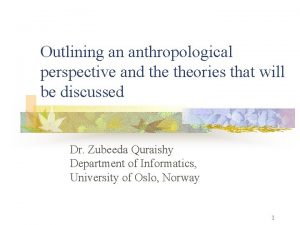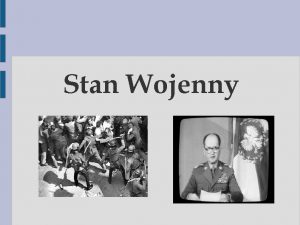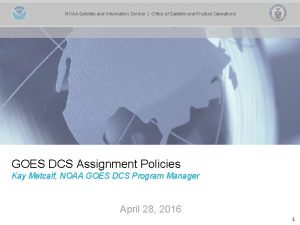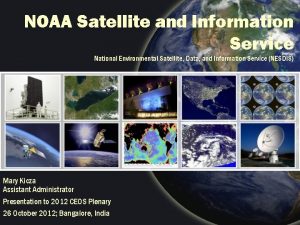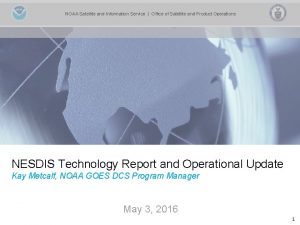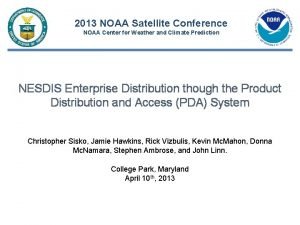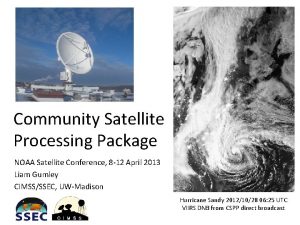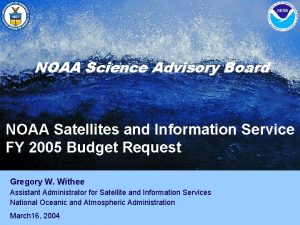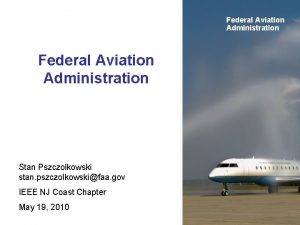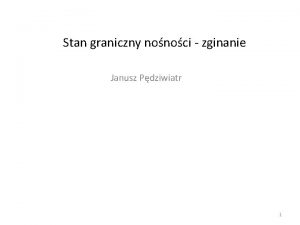NOAA Programmatic Perspectives Stan Wilson NOAA Satellite Information





















- Slides: 21

NOAA Programmatic Perspectives Stan Wilson NOAA Satellite & Information Service IOVW Science Team Meeting, Annapolis, 9 -11 May 2011 1

NOAA Plans Beyond Quik. SCAT NOAA has been pursuing two avenues to meet its mission needs for Ocean Vector Winds • Plan A – Implement its own operational follow-on: – 1 st, XOVWM – a dedicated pair of operational missions – 2 nd, DFS piggyback on JAXA’s GCOM-W 2 & -W 3 • Plan B – Access and utilize OVW data from missions of other agencies/nations – EUMETSAT – India – China 2

Kicza to Freilich Letter dated 14 Jan 2011 • From either the weather or climate perspective… given other NOAA priorities, the DFS has…proven to be unaffordable… • We do not see this financial outlook improving in the foreseeable future. • NOAA recognizes the importance of scatterometry to NASA, especially maintaining the climate record. • NOAA also recognizes that – if a scatterometer meets climate needs, it will also be capable of meeting weather needs – assuming timely data access. 3

Kicza to Freilich Letter dated 14 Jan 2011 • While the NRC Decadal Survey recommended that NOAA pursue scatterometry, given our inability to act on this recommendation, we can appreciate the growing frustration within NASA and the scientific community about having a suitable pathway within the U. S. for some follow-on. • As a consequence, NOAA is prepared to have NASA assume full responsibility to decide on sensor and mission specifications for whatever might come next in scatterometry, just as it did for Quik. SCAT. 4

Ocean Vector Wind Virtual Constellation Stan Wilson, NOAA Hans Bonekamp, EUMETSAT B. S. Gohil, ISRO IOVW Science Team Meeting, Annapolis, 9 -11 May 2011

Group on Earth Observations (GEO) • Launched in response to the 2002 World Summit on Sustainable Development and the G 8 • Includes participation of 76 countries • Working to link the world’s diverse monitoring networks into one Global Earth Observation System of Systems (GEOSS) • Promotes full and open sharing of data 6

Committee on Earth Observation Satellites (CEOS) • Planning the space arm of GEOSS • Forum of 29 space agencies • Introduced the concept of Virtual Constellations – OVW, OST, OCR, SST, Precipitation… – – Promote standard data products Collaborate in research and demonstrations Provide timely access for operational use Harmonize satellite orbits to optimize coverage

GLOBAL SCATTEROMETER MISSIONS Launch Date 08 09 10 11 12 13 14 15 16 17 18 19 20 21 22 C-band 10/06 EPS SG Europe Ku-band 6/99 Quik. SCAT USA Combined C- and Ku-band FY-3 E with 2 FS China Operational Series with 2 FS India Operating Extended Approved sw 13 apr 11

Brief History – ISRO Oceansat-2/OSCAT • 30 Jun 2005 – U. S. -India JWG – ISRO expressed interest in using Quik. SCAT data, but did not yet have a data policy for Oceansat-2. • 28 Feb 2007 – U. S. -India JWG – Verbal agreement to initiate joint scatterometer project with timely access to global data. • 23 Sep 2009 – Oceansat-2 launched. • 18 Nov 2009 – Kicza-Freilich-Navalgund sign Letter of Intent. • 23 Nov 2009 – Quik. SCAT terminated scanning mode. • Early summer 2011 – ISRO to begin operational phase for OSCAT. • In just 4 years, ISRO has expanded the mission from a “regional” to a “global” operational demonstration, and from a restrictive data policy to timely access to OSCAT for all users! 9

10

11

12

13

14

15

Scatterometry Plans in India • ISRO is planning a Scat. Sat to carry an OSCAT-type scatterometer plus a combined microwave imager and atmospheric temperature profiler. – Proposal is currently under review, with approval expected by the end of 2011. – Timely data access to be provided as with OSCAT. • ISRO is planning an operational series of satellites carrying a twofrequency scatterometer, with an initial 2016+ launch date. 16

Scatterometry Plans in China • State Oceanic Administration (SOA) – To launch HY-2 A with a Kuband scatterometer in July – No timely access; possible delayedmode access, except no Chinese coastal data. • Chinese National Space Agency (CNSA)/CNES – CFOSat planned for 2014 launch with a Ku-band scatterometer – data to be available “for marine forecasting”. • Chinese Meteorological Administration/National Satellite Meteorological Center (NSMC): – Once SOA has demonstrated scatterometry on HY-2 A, NSMC will start work on a two-frequency scatterometer to launch in 2016+ on FY-3 E. – NSMC says there will be timely access to the data. 17

GLOBAL SCATTEROMETER MISSIONS Launch Date 08 09 10 11 12 13 14 15 16 17 18 19 20 21 22 C-band 10/06 EPS SG Europe Ku-band 6/99 Quik. SCAT USA Combined C- and Ku-band FY-3 E with 2 FS China Operational Series with 2 FS India Operating Extended Approved sw 13 apr 11

Orbital Characteristics Mission Swath (km) Altitude (km) Overpass (descending) ASCAT Oceansat-2 Scat. Sat CFOSat 2 x 550 1800 900 817 720 520 0930 1200 0600 0700 19

20 Courtesy of Tim Liu

Summary • Timely data access to ocean vector winds: – ISRO is demonstrating that it will become a significant player in scatterometry. – The issue in China will likely resolve itself once CMA takes over scatterometry from SOA. • A thorough study – including EUMETSAT, ISRO, CMA, NASA and NOAA, as well as appropriate operational users – is needed to assess the benefits of harmonizing orbits to optimize coverage among as many as three two-frequency scatterometers in the 2016 time frame. 21
 Noaa satellite images
Noaa satellite images Noaa satellite images
Noaa satellite images The constellation
The constellation Programmatic risk examples
Programmatic risk examples Programmatic music
Programmatic music Programmatic research
Programmatic research Per fritiofson
Per fritiofson Perspectives in health information management
Perspectives in health information management Mussolini death
Mussolini death Strategic perspective of pay
Strategic perspective of pay George carlin football versus baseball
George carlin football versus baseball Three major theoretical perspectives in sociology
Three major theoretical perspectives in sociology Theoretical perspectives on the family
Theoretical perspectives on the family Four theoretical perspectives
Four theoretical perspectives Kw 6 personal perspectives
Kw 6 personal perspectives 7 contemporary psychological perspectives
7 contemporary psychological perspectives Social structure examples
Social structure examples Andrea yates psychology worksheet
Andrea yates psychology worksheet Professional nursing practice 7th edition
Professional nursing practice 7th edition Poems with two perspectives
Poems with two perspectives Experientalist
Experientalist What is perspective of anthropology
What is perspective of anthropology
